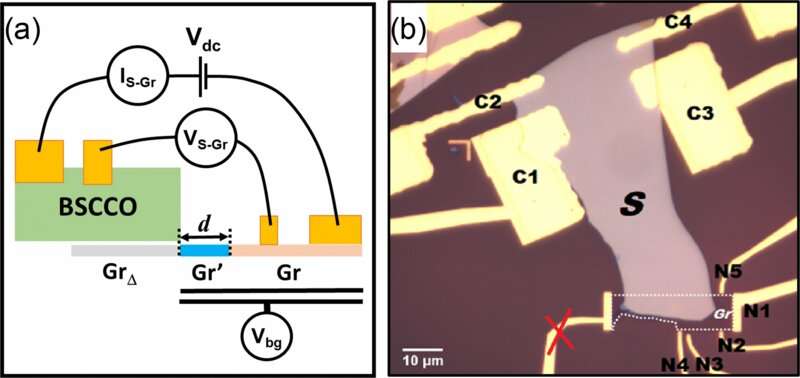This article has been reviewed according to Science X's editorial process and policies. Editors have highlighted the following attributes while ensuring the content's credibility:
fact-checked
peer-reviewed publication
trusted source
proofread
New kind of quantum transport discovered in a device combining high-temperature superconductors and graphene

Developing new quantum devices relies on controlling how electrons behave. A material called graphene, a single layer of carbon atoms, has fascinated researchers in recent years because its electrons behave as if they have no mass. For decades, scientists have also been interested in high-temperature superconductors: ceramic materials where electron interactions yield a macroscopic quantum state where electrons pair with each other. They do so at a temperature above the usual superconducting temperature of metals, which approaches absolute zero.
In a recent study published in Physical Review Letters, researchers from the SUNY Polytechnic Institute, Stony Brook University and the Brookhaven National Laboratory in the US, along with Aalto University in Finland, demonstrated a new electronic device that employs the unique ways in which electrons behave in these two materials—graphene and high-temperature superconductors.
The experiment, led by Sharadh Jois and Ji Ung Lee from SUNY with the support of theoretical work done by Jose Lado, assistant professor at Aalto, demonstrated a new quantum device that combines both graphene and an unconventional high-temperature superconductor.
In particular, the team demonstrated that the electronic transport between graphene and the high-temperature superconductor was dominated by a unique transport process arising from the combination of two peculiar properties: graphene's Klein tunneling and the superconductor's Andreev reflection. The team showed experimentally, for the first time, that this transport process was fully consistent with the existing theoretical predictions concerning hybrid Andreev-Klein electronic transport.
Tunneling and reflecting
The study relies on two unique phenomena found in these materials: Klein tunneling in graphene and Andreev reflection in unconventional high-temperature superconductors. Because graphene electrons behave as if they have no mass, they can move in situations where normal electrons could not. This phenomenon is known as Klein tunneling.
In turn, electrons in high-temperature superconductors form so-called Cooper pairs of two electrons. Cooper pairs can have unique mathematical structures, leading to unconventional superconducting states. When a Cooper pair forms exactly at the meeting point of a standard material such a piece of metal and a superconductor, it can result in a phenomenon called Andreev reflection, in which the pair "kicks back" another kind of particle into the metal.
While Andreev reflection involving conventional superconductors and metals is well understood, doing the same with graphene electrons and high-temperature superconductors had not been demonstrated until now.
A milestone in graphene quantum devices
"The demonstration of electronic transport stemming from graphene's Klein tunneling and unconventional superconducting pairing establishes a milestone in graphene-based quantum devices. This observation establishes the starting point to develop a whole new family of graphene-based superconducting quantum circuits that exploit unconventional superconductivity," Lado says.
The unique electronic properties of graphene have made it a promising platform for developing electronics that do not consume a lot of power. Conventional superconductors are key materials in a variety of quantum devices, and they are especially important in one of the strategies to build both qubit and topological quantum computers. By combining the two, the study's results can open new fundamental physics in these materials and ultimately establish a whole new platform for quantum technology devices.
More information: Sharadh Jois et al, Andreev Reflection and Klein Tunneling in High-Temperature Superconductor-Graphene Junctions, Physical Review Letters (2023). DOI: 10.1103/PhysRevLett.130.156201
Journal information: Physical Review Letters
Provided by Aalto University





















